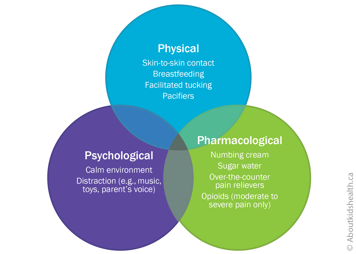When an infant is in the hospital and undergoing repeated painful procedures, it is important to respond to their pain frequently to minimize their risk for developing longer-lasting pain in the future.
Some researchers have suggested that ongoing pain during infancy, if not managed properly, can impact how an infant develops. For example, repeated exposure to skin-breaking procedures (such as needle pokes and IVs) can affect:
- how infants feel and react to pain later in life
- how well they can learn and pay attention
- how their brains grow
These findings highlight the importance of working with health-care professionals to prevent or reduce painful procedures whenever possible and make sure that your infant's pain is managed in the best way for their unique situation.
In broad terms, the most effective way to manage longer-lasting pain is to use a combination of physical, psychological, and pharmacological (medication) strategies. Together, these are called the 3Ps of pain control. Like three legs of a stool, the 3Ps are complementary, or supportive, to one another.

Psychological strategies
Creating a calm environment
Creating a calm environment positively affects the way infants react and recover from painful experiences. Babies understand body language, so it is important to manage your stress when you are with your baby during painful procedures.
Take a few calm deep breaths down into your belly. This slows down your breathing and heart rate, which if you are holding your infant in your arms, will slow down their heart rate and breathing and make them feel less distressed.
Distraction
Gently speak to your infant while they are in your arms. The sound of your voice will help distract them from any distress.
Physical strategies
Skin-to-skin contact
Skin-to-skin contact is also known as "kangaroo care". When you know your infant is about to undergo a painful procedure, ask to hold them for a few minutes. Ideally, hold your child clothed only in a diaper so that they are against your bare chest facing you. Start this at least 15 minutes before the painful procedure, but even two minutes of contact beforehand can help. You can wear a blanket or shirt for privacy and warmth. Mothers or fathers can offer skin-to-skin support.
Facilitated tucking
If you cannot do skin-to-skin contact, try giving your infant a "hand cuddle" (also known as "facilitated tucking"). This involves placing your hands on your infant while they are lying down to help them tuck their arms and legs into their body.
Breastfeeding
Breastfeed your infant during a painful procedure when they are old enough to co-ordinate sucking, swallowing and breathing. You can also put a dab of breast milk on a pacifier. Sucking with a regular rhythm on the pacifier helps to calm your infant.
Pharmacological strategies (medications)
Pain medicines can also minimize your child's pain. In general, when an infant is in the hospital, doctors and nurses will decide what medications to give them for acute procedures and surgeries.
If you are giving any pain medicines at home, always talk to a health-care professional first. They can advise you if the pain medicine is safe and effective for your child's type of pain.
Numbing creams
Numbing creams can be helpful for painful needle-related procedures such as vaccinations. Apply the cream to the area where the needle will be injected 30 to 60 minutes before the procedure, depending on the cream.
Sucrose or sugar water
Giving your infant two to three drops (0.1 mL) of sucrose (sugar water) about two minutes before a painful procedure can also reduce their pain.
Using a syringe or dropper, place the sugar water, one drop at a time, onto the front of your baby's tongue. You can also dip your baby's pacifier into the sugar water.
Only use sugar water when your baby is experiencing acute pain, not when they have general irritability.
Over-the-counter medications
It may also be helpful to give your infant acetaminophen or ibuprofen after a painful procedure as this can reduce the pain that persists. Speak to a health-care professional first if your infant is less than six months old.
Opioid medications
Opioids are among the strongest pain relievers and are often used after surgery or other major painful procedures. If your infant is in moderate to severe pain, their health-care team may prescribe opioids such as morphine, oxycodone or hydromorphone, generally for short-term use.
| Opioids have risks and side effects, which can be serious. Always talk to your child's health-care provider for advice on taking, storing and disposing of opioids safely. |
Websites
Comforting your baby in intensive care (in-depth PDF)
http://familynursing.ucsf.edu/sites/familynursing.ucsf.edu/files/wysiwyg/Comfy%20PDF%20ENGLISH%20Dec%2017.pdf
Videos
It Doesn't Have to Hurt: The Power of a Parent's Touch
https://www.youtube.com/watch?v=OlAItP-06hM
Dr. Marsha Campbell Yeo: What's the power of a parent's touch?
https://www.youtube.com/watch?v=XXzkAUV9ICE&t=132s
Reduce your infant's pain during newborn blood tests
https://www.youtube.com/watch?v=L43y0H6XEH4&list=PLlZczt8t4Ac8cW3pbuRKJAEs3SoC5y8MB
Content developed by Rebecca Pillai Riddell, PhD, CPsych, OUCH Lab, York University, Toronto, in collaboration with:
Lorraine Bird, MScN, CNS, Fiona Campbell, BSc, MD, FRCA, Danielle Ruskin, PhD, CPsych, Bonnie Stevens, RN, PhD, FAAN, FCAHS
Hospital for Sick Children
References
Debillion, T., Zupan, V., Ravault, N., Magny, J.F., Dehan, M. Development and initial validation of the EDIN scale, a new tool for assessing prolonged pain in preterm infants. Arch. Dis Child. Fetal 2001, 85, F36–F41.
DiLorenzo, M., Pillai Riddell, R., & Holsti, L. (2016). Beyond acute pain: understanding chronic pain in infancy. Children, 3(4), 26.
Pillai Riddell, R.R., Stevens, B.J., McKeever, P., et al. Chronic pain in hospitalized infants: health professionals' perspectives. J Pain. 2009;10:1217–1225.
Van Dijk, M., Roofthooft, D.W., Anand, K.J., Guldemond, F., de Graaf, J., Simons, S., de Jager, Y., van Goudoever, J.B., Tibboel, D. Taking up the challenge of measuring prolonged pain in (premature) neonates: The COMFORTneo scale seems promising. Clin. J. Pain 2009, 25, 607–616.
Van Ganzewinkel, C.J., Anand, K.J., Kramer, B.W., Andriessen, P. Chronic pain in the newborn: Toward a definition. Clin. J. Pain 2014, 30, 970–977.